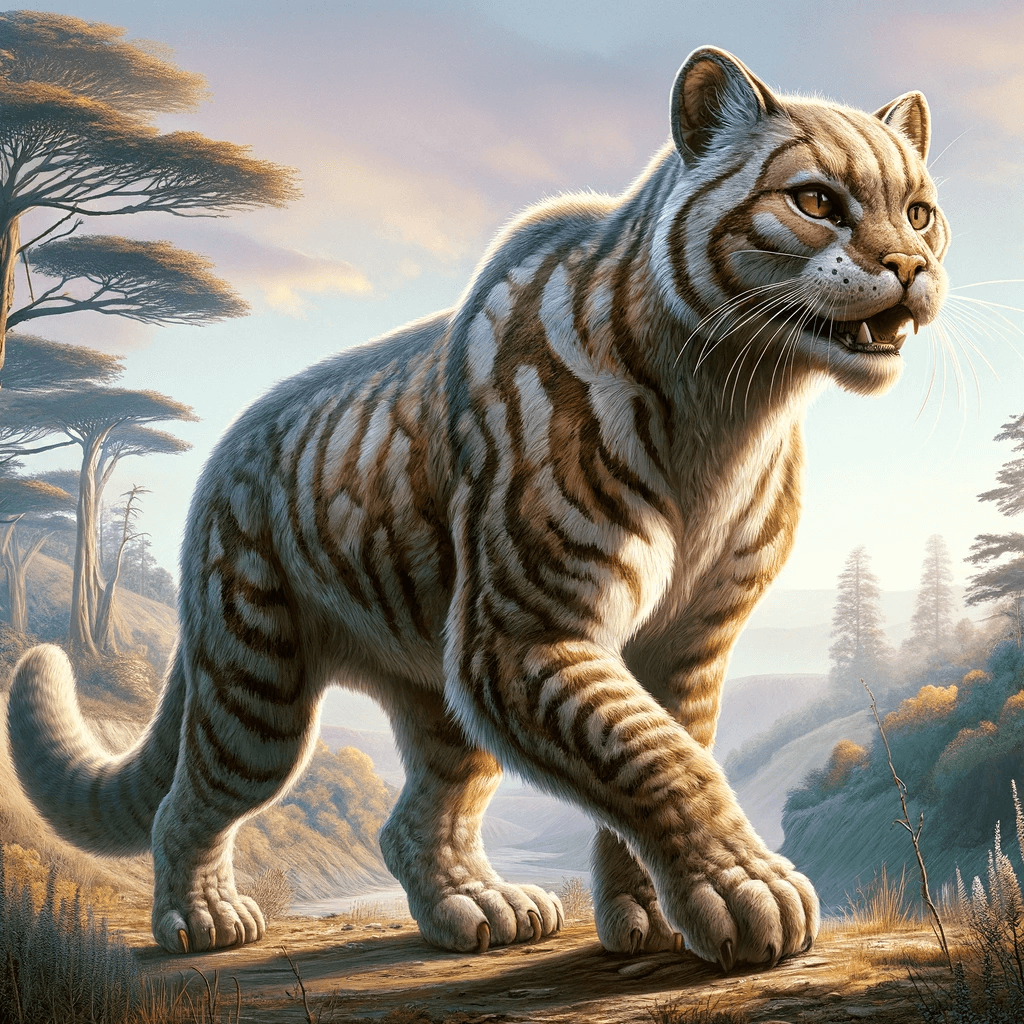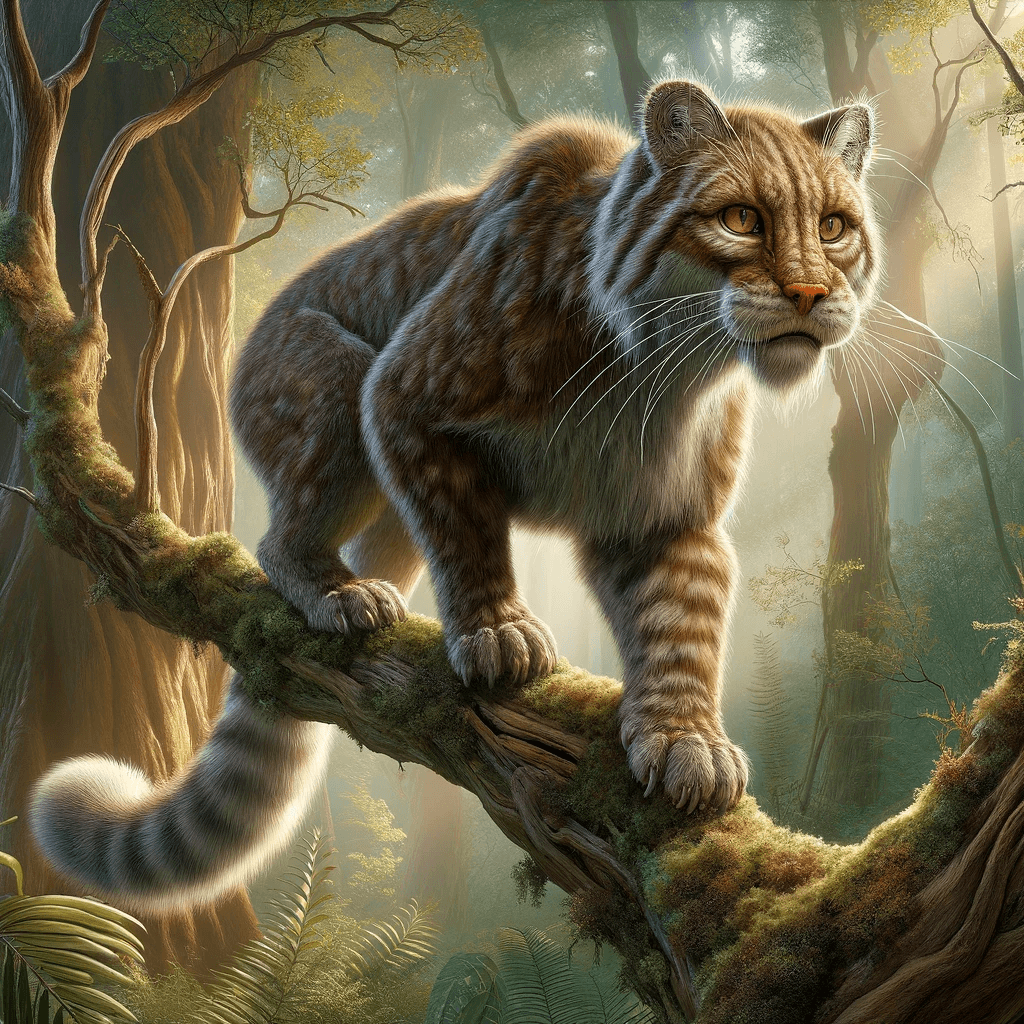Habitat and range
Eofelis, a genus of small nimravid false saber-toothed cats, existed during the Oligocene epoch, which was approximately 34 to 23 million years ago. As an extinct species, information about the habitat and range of Eofelis is limited. Still, researchers can make some inferences based on the fossil record, and today, I’ll explore some of what we already know and have discovered about this member of the cat family.
Based on the morphology of Eofelis, it is thought to have been a forest-dwelling predator that lived in the dense forests of Eurasia and North America. Its sharp, curved claws suggest that it was an agile climber and may have been able to pursue prey in the trees and on the ground.
Fossils of Eofelis have been primarily found in the phosphorites of Quercy, France.

Eofelis likely inhabited densely forested areas in Eurasia and North America during the Oligocene epoch, which would have provided much-needed warmth and shelter. Its adaptations for climbing and pursuit of prey in trees suggest that it was a highly specialized predator that played an essential role in the ecosystem of its time.
Eofelis, a genus of nimravid false saber-toothed cats, likely had distinct hunting habits and habitat preferences that they preferred. They hunted in groups and relied on camouflage to hide from predators, which they few of. Their skin was brown or tawny with dark spots or swirls that blended in with dappled grass.
They hunted on the ground and in trees and used their sense of smell to scent out potential prey, which is still prevalent in cats today. They also communicated through vocalizations and visual signals.
Their diets ranged from small rodents to large herbivores, which they often killed with a single bite to vital organs or necks. They were often predators in forests and wetlands, but they were also adaptable enough to live on the edge of extensive grasslands or plains where they could prey on smaller mammals such as the plentiful supply of rabbits.
Physical characteristics
Eofelis species were modest in size, characteristic of nimravids (false saber-toothed cats), with proportions significantly smaller than modern large cats. It was short-legged and heavily built, unlike modern cats, which tend to be sleek and long-legged.
It had a large head, open jaw, and long canine teeth. These were adapted for shearing prey and were oval in cross-section to retain strength while minimizing resistance as they sunk their teeth into their prey.
Eofelis, with its nimravid lineage, exhibited a lightweight build, more akin to smaller predatory mammals during the period. It had a long, muscular body, powerful jaws, and sharp, curved claws, suggesting it was a highly effective and adaptable predator. Its limbs were relatively short and robust, which may have made it better adapted for climbing and pursuing prey in trees than for chasing prey on the ground, which might be where in the DNA of modern cats, they still enjoy climbing furniture and trees.
The dentition of Eofelis, marked by its unique saber-toothed features, sets it apart from the true, in the sense of the word, cats of the Felidae family. Eofelis had large, sharp canine teeth that were recurved and serrated, which were used for hunting and killing large prey should they need to tackle some. Generally, during the colder winter months, they would brave it to take on a larger mammal in the hope of a more plentiful supply of food
Its molars were also relatively large and flattened, which suggests that it may have been an opportunistic feeder, able to consume a wide range of prey. Its teeth and jaw had developed to consume the thick-skinned meat of the time and yet still stay workable enough for rodents.
Overall, Eofelis was a large, powerful predator with adaptations for climbing and hunting in forested environments.
Eofelis might have employed diverse hunting tactics suited to its environment and physical attributes, possibly including ambush strategies. They had a powerful downward lunge of their head and could snatch at prey within their reach with their strong hind legs.
Their clavicle, more commonly known as the collarbone, was reduced in size so that it was not connected with other bones and could be buried deep in the muscles of their shoulder region. This allowed them to spring on their prey without risking breaking the bone due to the sheer force used and landing on impact.
While smaller cat species like the clouded leopard exist in different families, Eofelis belongs to the nimravid family, distinct from these modern felines. These small, nocturnal cats are found in Nepal and Southeast Asia and are declining because of habitat loss and hunting.
Hunting behavior
Eofelis, typically small in stature, may have been an adept predator, relying on agility and stealth rather than sheer strength. Its sharp, curved claws and robust limbs may have made it well-suited for pursuing prey in trees and on the ground. The large, sharp canine teeth of Eofelis were recurved and serrated, which would have been used for hunting and killing larger prey.

The hunting methods of Eofelis remain a subject of paleontological speculation, though its physical traits suggest it could have employed a range of predatory tactics. Its large size and powerful jaws would have allowed it to take down large prey, such as other mammals, reptiles, and bigger birds nesting in trees. It may have also been an opportunistic feeder, able to scavenge on carrion or consume a variety of prey depending on availability.
The morphology of Eofelis also provides insights into the ecological dynamic and makeup of the ecosystems in which it lived. As a forest-dwelling predator, it may have played an essential role in controlling populations of herbivores and shaping the evolution of prey species through predation pressure.
Overall, the specific hunting behavior of Eofelis needs to be more well-known. Still, its physical characteristics and adaptations suggest that it was a highly effective and specialized predator that played an essential role in the ecology of its time. We can look at the distinct characteristics of the modern wild cat and still see similar hunting traits.
Social company
Understanding the social behavior of extinct nimravids like Eofelis is challenging, as their lineage and behaviors may have varied significantly from those of extant Felidae family members. However, some species of cats, such as cheetahs and lions, do exhibit social behaviors and live in groups under certain circumstances.
Additionally, the fossil record of Eofelis indicates that it was relatively rare to find social groups living together, with only a few individuals found in any given area, which further suggests that it was not a highly social species.
Overall, while the specific social and family lifestyle of Eofelis is not well-known, it is likely that this genus lived a mostly solitary lifestyle, with individuals coming together primarily for mating. It’s funny that in the modern house cat, you can have a cat that is friendly to other cats and sociable, and you can have a cat that fiercely protects its territory. So, we will still have to wonder if the Eofelis ever experienced a difference in thinking.
Environment
They were not as large as a tiger, but they likely had long legs and retractile claws like the modern lynx. They were mainly nocturnal and hunted on open plains, where their sandy brown or tawny hues blended with drier or barer backgrounds.
The environmental conditions experienced by Eofelis, a nimravid genus, would have differed from those of later cat species, reflecting its era’s unique ecosystems and climates. Still, based on the fossil record and the morphology of related species, researchers can make some inferences about the ecosystems in which they lived.
Eofelis is a forest-dwelling predator with adaptations for climbing and pursuing prey in trees. This suggests it lived in forested environments, likely abundant during the Oligocene. The climate of the Oligocene was relatively warm and humid, with lush forests covering much of the world.
At the same time, the world was experiencing a shift towards a more seasonal climate, with more significant fluctuations in temperature and precipitation. This may have affected the distribution and abundance of prey species, influencing the distribution and behavior of predators like Eofelis.
Overall, Eofelis lived in forested environments during a significant environmental transition. The lush forests of the Oligocene provided an ideal habitat for this forest-dwelling predator, which likely played an essential role in the ecological dynamics of its time.
Historical lessons
Eofelis, a genus of nimravids, offers insights into the diversity of extinct predatory mammals distinct from the modern cat lineages in the Felinae family. During the past ten million years, sea levels were lower than they are today, and the aforementioned ice ages facilitated the formation of land bridges of various sizes that allowed mammals to traverse vast distances.
Research into extinct genera like Eofelis enriches our understanding of prehistoric biodiversity and the distinct evolutionary pathways of various mammalian groups. Here are some examples:
Eofelis and other extinct felids’ morphology provides insights into the evolution and adaptation of large predatory cats and how they have responded to changing environmental conditions over time. By understanding the adaptive traits of Eofelis, we can better understand the ecological dynamics of past ecosystems.
Climate change and environmental transition: The Oligocene epoch, when Eofelis lived, was a time of significant climate change and environmental transition. By studying the fossil record and the ecology of this period, we can gain insights into how ecosystems respond to changes in temperature and precipitation and how the distribution and behavior of species are affected.
Biodiversity and extinction: Eofelis is just one of many species that have gone extinct throughout Earth’s history. By studying extinct species like Eofelis, we can better understand the factors that lead to extinction, such as changes in climate, habitat loss, and competition with other species. This knowledge can help us better manage and conserve the biodiversity of currently threatened or endangered species.
Biogeography and connectivity: The discovery of Eofelis fossils in France offers a glimpse into the biogeography of the Oligocene epoch in Europe, shedding light on that era’s ecosystems and species interactions.
Keystone species and ecosystem dynamics: The study of Eofelis contributes to our understanding of predator-prey dynamics in ancient ecosystems, although its specific ecological role remains a subject of paleontological research. Understanding the role of predators like Eofelis as keystone species in past ecosystems can provide insights into the complex dynamics of modern ecosystems.
Paleontology and comparative anatomy: The study of Eofelis and other extinct species is an integral part of the field of paleontology, which uses the fossil record to reconstruct the history of life on Earth. By comparing extinct species’ morphology and behavior with living species, researchers can gain insights into the ecological and evolutionary processes that have shaped life on Earth.







